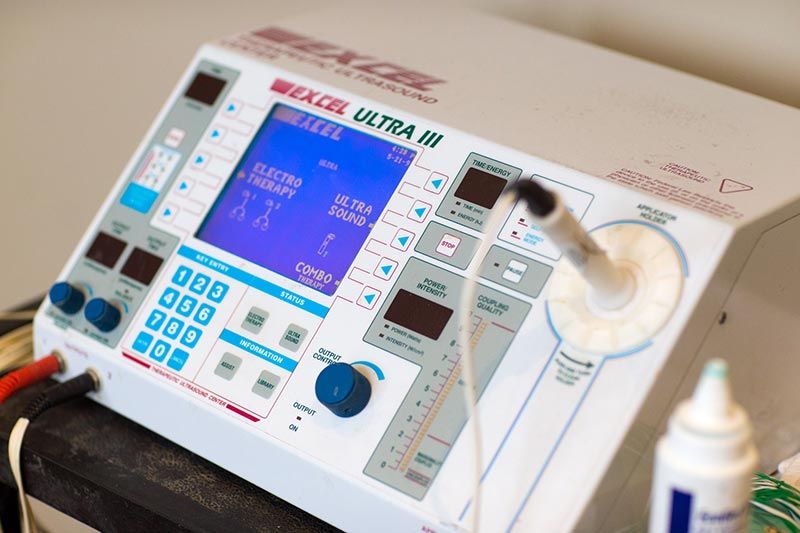Therapeutic Ultrasound
What is it?
Ultrasound is a therapeutic modality that uses sound wave technology, applied by manual therapy practitioners for greater than sixty years. Ultrasound is administered using a round-headed wand or probe that is put in direct contact with the patient's skin over the affected area. Therapeutic ultrasound is in the frequency range of about 1.0 - 3.0 MHz.

How does it work?
The ultrasonic waves are generated by what’s known as a “piezoelectric effect”, caused by the vibration of crystals within the head of the ultrasound wand/probe. These sound waves pass through the skin and cause a vibration of the local tissues, thereby creating a deep heating locally (although often no sensation of heat will be felt by the patient). In situations where a heating effect is not desirable, such as a new injury with acute inflammation, the ultrasound can be pulsed rather than continuously transmitted.
What are the benefits of it?
Research has shown therapeutic ultrasound to cause increases in tissue relaxation, local blood flow, and scar tissue breakdown. The effect of the increased local blood flow includes that of a local reduction in swelling and chronic inflammation. Further, according to research, this increased local blood flow can promote bone fracture healing. The intensity (or power density) of the therapeutic ultrasound can be adjusted depending on the desired effect. For example, a greater power density (measured in watt/cm2 ) is often used in cases where scar tissue breakdown is the goal.
How long is a session of ultrasound?
Typically, an ultrasound treatment will last from 5-10 minutes depending on the size of the area being treated. In cases where scar tissue breakdown is the goal, this treatment time can be significantly longer. Ultrasound treatment is often used in combination with other treatment types (such as manual therapy, muscle work, exercises, electro-modalities, etc) which will obviously increase the overall length of the treatment.
Does treatment hurt?
Not in the least.
Can ultrasound be used for any other purpose?
Interestingly, if we were to assess you for a bone fracture, ultrasound could be utilized to aid us in the diagnosis. If there is even a very minor break in a bone in the area that is close to the surface, a sharp pain may be felt with ultrasound application. This occurs as the sound waves get trapped between the two parts of the break and build up until becoming painful. In this way ultrasound can often be used as a relatively accurate tool for diagnosing minor fractures that may not be obvious on x-ray. (We think that’s pretty cool).
Are there any contraindications to therapeutic ultrasound treatment?
A few. These may include local malignancy (application of ultrasound to a cancerous site), metal implants below the area being treated, local acute infection, vascular disorders, and direct application of the wand on the abdomen of pregnant women. Further, it is contraindicated to apply therapeutic ultrasound directly over active epiphyseal regions (growth plates) in children, over the spinal cord in the area of a laminectomy, or over the eyes, skull, or testes.
I have more questions. Who can I contact?
For further information, please feel free to contact Dr. Carney. He’d be more than happy to discuss any questions that you may have.
Conditions Treated
- Tendon Injuries
- Muscle Injuries
- Ligament (sprains) and Joint-related Injuries
- Muscle Spams
- Swelling
Next Steps
Are you a new or potential patient of ours? Be sure to download, fill out and bring along any relevant forms to your first appointment:
Be sure to Contact Us or click on the button below to schedule a free telephone consultation:
